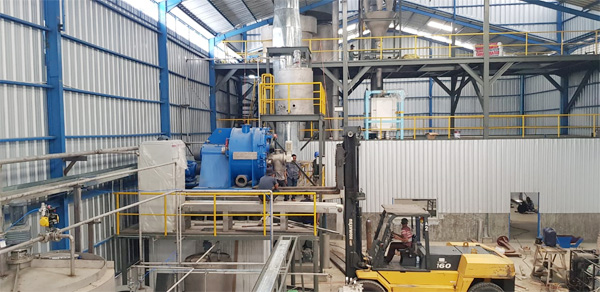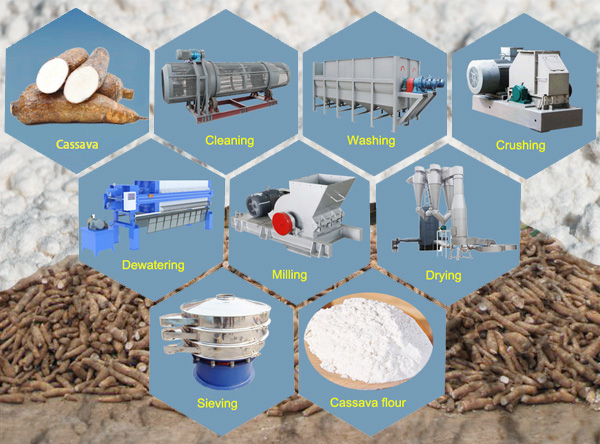Commercial cassava production and processing
Cassava is one of the world's three major potato crops, it is rich in starch. It has a cultivation history of nearly 5,000 years. Cassava is widely distributed between 30° north and south latitudes. It is easy to plant and adaptable. It is used in dryland agriculture occupied an important position.
Cassava is the most important source of heat energy in tropical and subtropical regions, and its tender stems and leaves are a good source of protein. Within the unit area, cassava has more food energy than rice, wheat, sorghum and corn, and is one of human's main food resources. As a food, cassava is the food that the world's more than 500 million people depend on for survival. In addition to being used as human food, cassava root is used as a feed and an important raw material for industrial processing.
 Cassava starch processing plant machines
Cassava starch processing plant machines
Commercial cassava processing mainly refers to the economic benefits of cassava after processing. Using cassava as raw material, it can produce three series including more than 2,000 products, which plays an important role in chemical, pharmaceutical, textile, paper and food. Because cassava has a wide range of uses and unique advantages, and after processing, the added value of cassava products can be several times or even hundreds of times, so it is recognized as a renewable energy crop with great development potential. The comprehensive utilization of commercial cassava production and processing is summarized below.
1. The edible value of cassava
65% of the world's total cassava production is used for human consumption and is the main food crop for low-income farmers in tropical wetlands. Currently in Africa, almost all cassava is consumed as food, and about 40% of it is processed into various foods in Latin America. In addition to India and Indonesia as a supplement to food in Asia, cassava is rarely used as a food crop in other countries, but industrial processing of cassava such as starch, alcohol, and starch sugar.
The leaves of cassava are also edible. They are rich in protein, VA, VB and VC. The nutritional value of cassava leaves is similar to that of soybean. It is a good vegetable protein and can be eaten as vegetables because it contains more solid materials than ordinary vegetables. It is several times higher. It is not as soft as ordinary vegetables after cooking. Therefore, it is necessary to smash or smear the leaves before cooking, and then use them as raw materials for cooking soup or fried ingredients. In addition, cassava can also produce a variety of foods such as fans, shrimp slices, sauces, pastries, pancakes, potato chips (silk, strips). Nowadays, with the improvement of people's living standards, cassava is becoming more and more popular as a miscellaneous grain.

2. Feeding value of cassava
The cassava root can replace the cereal component in the compound feed. As a heat energy feed for livestock and poultry, the price is lower than 1/3 of that of corn. Reasonable use can reduce the cost of feed by 30%.
The cassava leaves are rich in nutrients and are a good protein feed. The fresh cassava leaves contain about 30% dry matter, the common fresh leaves contain 7%~9% crude protein, and the dry leaf powder contains 20%~30% protein, all of which are amino acids. The content is 8.4%~9.4%. Except methionine is lower than the critical level, other major amino acids are quite abundant, including carotene, crude fiber, crude protein, calcium, vitamins and trace elements, which can be used with most tropical legumes. Comparable, even better, can raise fish and silkworms.
According to the nutritional value of cassava leaves, many places promote the use of cassava leaves as feed for livestock and poultry in the development and utilization of feed. First, the cassava leaves are picked and dried to make grass powder and added to the feed to feed the livestock and poultry. The second is to feed the cassava leaf silage to the livestock and poultry. The cassava leaves will not be poisoned after being fed to the livestock and poultry after silage fermentation. After the silage process, the harmful components are acidified, the nutrients in the cassava leaves will not be lost, some microbial proteins will be added, and the texture is soft, and the livestock loves to eat. For the development of animal husbandry and aquaculture, grain food can be saved.
 Cassava processing machine design and delivery in Doing Factory
Cassava processing machine design and delivery in Doing Factory
3. Industrial use value of commercial cassava processing:
The cassava root contains 30% starch and the dry cassava chips contains 70% starch. Moreover, the cassava starch is fine in powder and contains less impurities such as protein, and the amylose in the starch accounts for 17%, and the amylopectin accounts for 83%. Cassava starch processing separates starch from cassava raw materials with other substances such as cellulose, protein, and inorganic salts. In the production process, the root starch is insoluble in cold water and the specific gravity is greater than water. The water and the special cassava starch processing machine separate the starch from the water suspension to achieve the purpose of extracting the starch.
There are three main types of commercial cassava starch processing products: First, modified starch, widely used in textile, paper, medicine, food, building materials, foundry, light industry, petroleum, energy, feed, agriculture, environmental protection, bioengineering and other industries; It is a chemical product. Organic chemicals produced from cassava starch include alcohol, polyethylene, acetic acid, ethylene oxide, sorbitol, ethanolamine, citric acid, etc., which are used to produce rubber, pesticides, greases, packaging products, cosmetics, and military products. Important raw materials, especially alcohol, are added fuel in gasoline, and the market potential is considerable. Currently, it is used as a substitute for gasoline in other countries in China and abroad. Third, starch sugar, cassava starch can produce glucose, fructose, fructose, maltose, Dozens of sugars, such as high-sugar, oligosaccharides, oligosaccharides, oligosaccharides, and trehalose, are emerging health foods. They have become the new favorite in the international candy market and have strong market competitiveness.
In addition to cassava starch, in many countries in Africa, cassava is widely processed into cassava flour and garri, which plays an important role in daily diet, and cassava flour can be further processed into many kinds of foods, which are also widely used in breadmaking.
 Main DOING cassava processing machines
Main DOING cassava processing machines
4. Planting value of cassava rod and cassava skin
Cassava rods and cassava skin are good raw materials for the cultivation of edible fungi such as black fungus and poplar mushrooms. In addition, cassava rods and cassava skin can also be used as field fertilizers to avoid environmental pollution caused by incineration, increase soil organic matter content, improve soil structure, increase crop yield, reduce farmers' investment, and increase income.
The roots, stems and leaves of cassava all can be used. Cassava is widely used in many fields such as industry and agriculture. Commercial cassava processing can bring high economic benefits and has broad development prospects. It is worthy of research and investment. Now, depending on cassava starch processing, Thai get a very high profit each year. For Africa, from our customer's feedback, the commercial cassava processing mainly divided into starch extraction, cassava flour processing and garri processing. These three products all can get a high profit, but the processing factory in Africa is very lack, maybe garri processing is not little, but nearly all is small scale family processing, difficult to meet the market demand. I just want to tell you that Doing Company dedicated in cassava processing machines design and fabrication, we can support you machine and technology if you plan to start a cassava processing business in any time.
 PREV:Analysis on the development status of world cassava production
PREV:Analysis on the development status of world cassava production
 NEXT:Starch hydrocyclone station,fine white starch production key equipment
NEXT:Starch hydrocyclone station,fine white starch production key equipment




